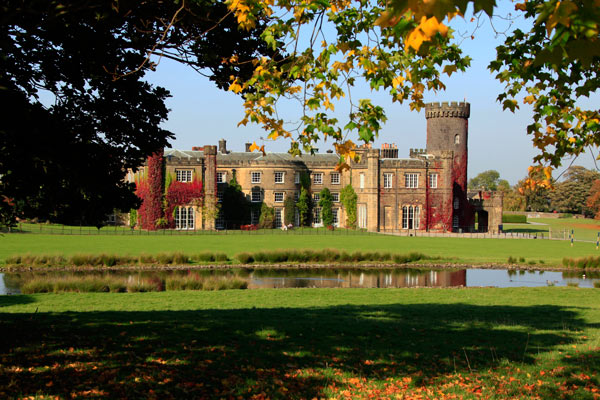- £85,551 funded towards developing a new business model for multi-functional forestry on Swinton Estate in Masham, North Yorkshire. The project aims to create and manage woodlands to optimise the balance of environmental and commercial outcomes, generating revenue from forestry including timber. It will monetise wider benefits from carbon sequestration, biodiversity credits, recreation, and water quality.
- North York Moors National Park Authority granted £99,261 to develop catchment-scale river restoration in conjunction with the Esk Valley Farmers Group (EVFG). This will take place in the Esk catchment area of North York Moors and Whitby; the organisations aim to pilot an approach that will be a blueprint for catchment-scale nature restoration applicable across all National Parks.
- £98,000 funding granted towards National Trust for a project to improve woodland cover and lead to wider natural flood management in the Upper Calder and Colne catchment areas located in West Yorkshire and Lancashire. This will lead to landscape change and aim to monetise benefits such as from natural flood risk outcome payments, carbon, and biodiversity credits.
The UK Centre for Ecology & Hydrology (UKCEH) aims to develop a saltmarsh code to support habitat restoration activities at three sites with the potential to build a wide umbrella Blue Carbon Code applicable in wider marine habitats. This will take place in several locations, including at Skeffling on the north bank of the Humber estuary, with £99,931 funded by the government.
Projects to restore kelp forests, create new woodland, deliver natural flood risk management, and improve water quality are among an initial 27 schemes to benefit from a pioneering new fund to drive private investment in nature and tackle climate change, Defra, the Environment Agency & Natural England have announced today (14 July 2021).
Organisations across England have been awarded up to £100,000 each, as part of the ground-breaking £10 million Natural Environment Investment Readiness Fund. The funding will be used to develop the projects to the point they can provide a return on investment by capturing the value of carbon, water quality, biodiversity and other benefits provided by natural assets such as woodlands, peatlands, catchments and landscapes.
Funding has been awarded to environmental groups, businesses and local authorities to develop projects that protect and enhance nature while also demonstrating innovative approaches to generating revenues from the wide range of benefits that nature provides.
Revenues will be generated through the sale of carbon and biodiversity units, natural flood management benefits and through reduced water treatment costs. In developing these revenue streams, the Fund will help create a pipeline of projects for the private sector to invest in, and develop new funding models that can be scaled and replicated elsewhere.
Projects receiving funding focus on tackling climate change and restoring nature through schemes such as woodland and habitat creation, peatland restoration, sustainable drainage and river catchment management.
Examples include developing a carbon credit model for saltmarshes across England; kelp forest restoration off the Sussex coast; woodland creation in North Yorkshire; and peatland restoration in Greater Manchester.
Environment Minister Rebecca Pow said:
To tackle the environmental challenges we face from climate change and biodiversity loss, it is crucial that domestic natural environment projects are able to attract private investment alongside support from the public sector.
Unleashing innovation and growing new sources of finance, such as through the Natural Environment Investment Readiness Fund, are fundamental for delivering nature recovery and developing nature-based solutions to achieve net zero carbon emissions by 2050.
Chair of the Environment Agency, Emma Howard Boyd said:
With the right structure, nature-based projects can be scaled up by private finance, helping to reduce emissions, prepare for climate shocks and create jobs.
From a new business model for multi-functional forestry in Yorkshire, to an investment fund to transform farmland in Norfolk, these projects will provide evidence of funding models to make industries fit for the future, reach net zero by 2050, and create a nature positive future.
With COP26 coming to the UK this year, this demonstrates how to create investable propositions for nature based solutions to the climate emergency.
Tony Juniper, Chair of Natural England, said:
Restoring Nature is essential for tackling climate change and supporting a strong, sustainable economy. Mobilising private finance can make a huge contribution to this and NEIRF is among the steps needed right now to help unlock that investment.
I am very pleased that Natural England is providing technical input into the fund, helping to identify projects that will enable the public, private and charitable sectors to collaborate in genuine partnership to deliver nature recovery and action on climate change.
Working on behalf of Defra and HMT, delivery partners the Environment Agency, Natural England and the Access Foundation for Social Investment will support the projects and make the knowledge generated available to the public to encourage similar approaches to access private sector finance for nature projects in the future.
The Green Finance Institute (GFI) has supported DEFRA and the Environment Agency throughout the Fund’s launch including leading a series of educational workshops for interested applicants, and acting as third party assessor and advisor over the application and awards process.
Chief Executive of the GFI, Dr Rhian-Mari Thomas said:
The recent Dasgupta Review made clear the value of nature to our economy and society and the need for investment in nature-positive projects. The Fund will accelerate private investment in nature, as will the learnings derived from the successful applicants and their projects. We look forward to continuing our support for this transformative initiative.
Subject to confirmation, the Environment Agency and Defra are planning to launch a further application round later this year.
Since the Prime Minister’s 10 Point Plan publication we have enshrined the UK’s sixth carbon budget in law, proposing a target which would reduce greenhouse gas emissions by 78% by 2035 compared to 1990 levels.
We are also encouraging countries to join the UK’s call to protect at least 30% of the global ocean within Marine Protected Areas (MPAs) by 2030, as announced by the UK at the UN General Assembly in September 2018. We were also the first major economy to set a legally binding net zero greenhouse gas emissions target by 2050.
| Project | Applicant | Grant | Detail |
| New Forest Net Zero: Investment Models for Nature Restoration | New Forest National Park Authority | £99,229 | Map the restoration of arable and neutral grasslands to woodland and fens, across three public and privately owned sites within the NPA in an area of high development pressure. The project will scope work needed to restore woodlands and wetlands, resulting in carbon sequestration, habitat creation and improvements in water quality.
Revenues from these ecosystem services will then be modelled in the form of carbon, nutrient and biodiversity credits to demonstrate a case for private investors.
|
| UK Soil & Farm Carbon Code-Piloting and developing carbon investment readiness | Farming and Wildlife Advisory Group South West (FWAG) | £98,000 | Building on a three year partnership investigating regenerative agriculture and carbon, aiming to propose a UK Farm and Soil Code in 2022.
Through this project carbon on farms will be monetised, particularly through regenerative agricultural practices enhancing carbon sequestration in soils.
|
| Crystal Clear Clyst Bond | East Devon District Council | £100,000 | Seek to convert farmland to woodland in an area experiencing a growth in development, via an Environmental Impact Bond. This is a council driven project and will lead to the conversion of agricultural land to woodland.
It will monetise revenue generation from voluntary carbon credits, biodiversity credits from new habitat recreation and the Community Infrastructure Levy.
|
| The Wildlife Trusts’ Habitat Banking Investment Model | Berkshire, Buckinghamshire, Oxfordshire Wildlife Trust | £100,000 | Develop a new habitat banking investment model to deliver biodiversity net gain at scale. The project is a consortium of Wildlife Trusts and will define habitat restoration and creation of grassland, wetland and woodland at three sites for carbon storage, improved flood resilience and visitor well-being.
The project will monetise potential for revenue generation through biodiversity credits.
|
| Sussex Bay kelp: a carbon model for kelp forest restoration | Adur District & Worthing Borough Councils | £79,000 | Restore the kelp beds that have been lost to trawling and create a blue carbon bank to support and sustain the restoration of a large kelp forest in the new Trawler Exclusion Zone between Selsey Bill and Shoreham.
The project will explore the voluntary market in blue carbon sales and proposes to monetise a wide revenue streams from kelp restoration in the form of aquaculture, tourism, coastal erosion and flood risk and wate quality.
|
| Wilder Carbon Standard | Kent Wildlife Trust | £100,000 | Create a finance facility to facilitate the restoration of nature at scale funded by carbon finance. The project will test and develop the ability to generate new revenue streams across multiple habitats. In particular this project will develop a carbon standard which can be linked to wild habitats and generate revenues from biodiversity credits. |
| Developing a new business model for multi-functional forestry on Swinton Estate | Swinton Estate (The Trustees of Swinton Heirs Trust) | £85,551 | Create and manage woodlands to optimise the balance of environmental and commercial outcomes whilst reducing the intensity of farming on an estate.
The project will generate revenue from forestry including timber and will monetise wider benefits from carbon sequestration, biodiversity credits, recreation, and water quality.
|
| Greater Manchester Environment Fund: Scaling Up Natural Capital Investment | Lancashire Wildlife Trust | £100,000 | Raise investment to restore peatland through the Greater Manchester Environment Fund by modelling revenues from the sale of carbon and biodiversity credits through woodland creation and increasing biodiversity. |
| Financing Wetlands for the Stiffkey using Environmental Impact Bonds | Norfolk Rivers Trust | £70,000 | Develop an Environmental Impact Bond to reduce phosphates and other pollutants entering the River Stiffkey, reducing the harm to biodiversity.
The project will model revenues from this intervention in the form of phosphate credits and it will explore other ecosystem services for additional revenue sources.
|
| Wendling Beck Exemplar Project (WBEP) | Norfolk Wildlife Trust | £99,718 | Create an investment fund to deliver a landscape scale catchment project to transform farmland through river restoration, grassland and wetland creation.
The project will model revenue generated from sales of biodiversity, carbon and nutrient credits.
|
| An investment model for catchment-scale nature restoration in the Esk Valley | North York Moors National Park Authority | £99,261 | Develop catchment scale river restoration, which will be funded through the monetisation of carbon, biodiversity and water management. The National Park will work with the Esk Valley Farmers Group (EVFG) and pilot an approach that will be a blueprint for catchment-scale nature restoration applicable across all National Parks. |
| Warwickshire Carbon and Environmental Markets | Warwickshire County Council | £72,000 | Build and broaden the scope of the Warwickshire biodiversity net gain market, to bring in wider ecosystem benefits including carbon and catchment services.
The primary focus of the project is to expand the biodiversity net gain market to woodland carbon and blend public funding for tree planting with carbon credits.
|
| A Natural Capital Investment Company for Accelerating Delivery of Habitat Banks | Surrey Wildlife Trust | £100,000 | Establish a natural capital investment company to model biodiversity net gain at scale in support of development growth in the southern England.
The project will also explore and quantify income from natural flood risk management and carbon sequestration sources.
|
| Making the Case for Investment in The Tamar Valley’s Nature-Based Services’ | The National Association for Areas of Outstanding Natural Beauty | £99,163 | Develop a local ecosystem service market through testing trading mechanisms which will market benefits from environmental enhancement of five sites in the Tamar Valley.
The project will identify and monetise a range of benefits in the form of carbon, biodiversity credits, natural flood risk management, and water quantity improvement.
|
| A case for a UK Saltmarsh Carbon Code: Evidence, Intervention, and Investment | UK Centre for Ecology & Hydrology (UKCEH) | £99,931 | Develop a saltmarsh code to support habitat restoration activities. The project will involve ground truthing verification at three sites with the potential to build a wide umbrella Blue Carbon Code applicable in wider marine habitats.
The project seeks to develop a rigorous and scientifically based voluntary certification standard for those that want to market the climate benefits of saltmarsh restoration, with assurances to voluntary carbon market buyers that the climate benefits are quantifiable, additional and permanent.
|
| RSPB Natural Capital Investment Aggregation Vehicle | The RSPB | £59,638 | Develop a method to aggregate equity funding, which would finance habitat creation in a pipeline of projects.
It will seek to model revenues through biodiversity and carbon credits at significant scale, and it will model this approach in up to six pioneer sites.
|
| Landscapes for Water in the Calder and Colne Catchment | National Trust | £98,000 | Improve woodland cover and lead to wider natural flood management in the Upper Calder and Colne catchment, leading to landscape change and monetising a suite of ecosystem service benefits such as from natural flood risk outcome payments, carbon, and biodiversity credits. |
| Developing a Worcestershire Natural Capital Investment Partnership | Worcestershire County Council | £91,118 | Establish a county-wide natural capital investment framework for selling biodiversity credits via a habitat ‘bank’. The framework will offer scalability so that all Worcestershire local authorities can opt in.
The project will explore and model investment from a reduction of costs associated with flood risk; sequestration of carbon; provision of pollination services; providing physical and mental health benefits to the public through access to nature.
|
| Doubling Nature Investment Readiness Project | Mersey Forest | £96,000 | Establish a place based investment vehicle to improve the Bollin catchment through increased tree cover and improvements to heathland, bog and wet grassland.
The project will model investment through a bond repayable through biodiversity, carbon credits and catchment services such as natural flood risk management.
|
| Hadrian Bond | Regenerate Outcomes Company | £100,000 | Establish an Environmental Impact Bond to stimulate regenerative agricultural practices across a suite of farms.
The project will seek to fund the Environmental Impact Bond through modelled revenue from regenerative agriculture, carbon, biodiversity credits and potentially wider catchment services such as improved water quality.
|
| Creation of a Hedgerow Carbon Code. | Allerton Research & Educational Trust | £81,561 | Develop a hedgerow carbon code to support habitat enhancement activities and measurement of carbon sequestration.
The project will include field trials leading to the development of a verification code, and determine the potential for enabling farmers to increase the amount of carbon stored in their hedgerows and trade carbon credits
|
| Buscot and Coleshill: Piloting Place-based Innovation for the National Trust | National Trust | £96,500 | Test a place based natural capital investment approaches centred on woodland and habitat creation, which will lead to wider socio economic and water management interventions.
The project will map and audit the potential monetisation of a range of ecosystem services from biodiversity and woodland creation, flood risk management, improved water quality and ecotourism.
|
| Protected Landscape Investment Bank | Cornwall Area of Outstanding Natural Beauty Trust | £99,500 | Develop landscape recovery funding and investment strategy which will detail a diverse set of income streams across catchment services, biodiversity and carbon off setting, tourism and health.
As part of the project, the AONB will map and audit the potential revenues from environmental enhancement activities resulting in water quality improvements, carbon sequestration, habitat creation, flood risk mitigation and wider services such as tourism, and health.
|
| Green Investment in Greater Lincolnshire (GIGL) | Lincolnshire Wildlife Trust | £100,000 | Establish market mechanisms to trade biodiversity, carbon and water credits generated through improvements to agricultural land at a landscape scale.
The project will quantify demand from buyers of biodiversity, carbon and water credits in Greater Lincolnshire and work with landowners to identify nature-based solutions, establishing a registry of pipeline of shovel ready projects.
|
| Environmental Impact Bond for phosphorus removal from the Irwell catchment | United Utilities Water Ltd | £66,500 | Establish an environmental impact bond model and an investment case to deliver up to ten sustainable drainage systems to industrial estates and other nature based solutions.
The project will result in an investment case supported by potential buyers, the transaction details, and how the interventions will be delivered. The project is expected to have relevance across the water sector.
|
| Cornwall Habitat Bank | Cornwall Council | £99,404 | Develop a countywide habitat bank aiming to be a one-stop shop with a brokerage service to deliver natural capital enhancements, biodiversity net gain and trial a blue carbon market.
The project will identify how to blend biodiversity and carbon credits with tourism and wider funding sources.
|
| The Carbon Bank | Ecotricity New Ventures | £89,675 | Identify and model woodland creation in a number of company sites, which will result in the creation and selling of woodland carbon a new and bespoke web platform to over 200,000 customers. |







